A Bengali, a Punjabi baker, a Gujarati law intern, and a Sindhi lawyer walk into a restaurant. They eat the food of the Indus Valley Civilisation, the vegetarian and the coveted non-vegetarian. And with each dish they taste, one or the other finds something in common with the food cooked in their home — a brinjal fry, a meat fat soup, or a fowl curry. That is the power of food and history coming together for one night. That is what the National Museum in Delhi didn’t want you to know. And that is how I spent my dinner at chef Saby’s Lavaash restaurant, connecting with people I didn’t know but with whom I clearly shared a food DNA from thousands of years ago.
After the last-minute non-vegetarian fiasco, the well-researched dinner planned by One Station Million Stories (OSMS) and chef Sabyasachi Gorai or Saby had to be moved out of the National Museum premises and into Lavaash restaurant in posh Mehrauli. It was part of the Historical Gastronomica event. Had the dinner happened at the museum, as it should have, it would have been the first of its kind in India. That would be in keeping with a true ‘museum tradition’ — connecting people to their history, accurately — rather than lying prostrate before ‘gods in galleries’, but only certain ones.
What the Harappans ate
The dinner would have been as accurate as Hrithik Roshan-starrer film Mohenjo Daro had we pretended that the people of the Indus Valley Civilisation did not eat animals and only consumed legumes and vegetables. In fact, 80 per cent of their protein intake came from animals.
It’s time we acknowledge that India’s history is diverse, our roots are diverse and that majoritarianism never made food tasty.
Soumi Chatterjee of OSMS and her team spent months researching the food of the Indus Valley Civilisation, what was eaten, how it was made, how were the ingredients sourced. Then this intensive knowledge of the ingredients and cooking was given to chef Saby, who only had three-and-a-half weeks to ideate and come up with dishes, but without overstepping the list given to him.
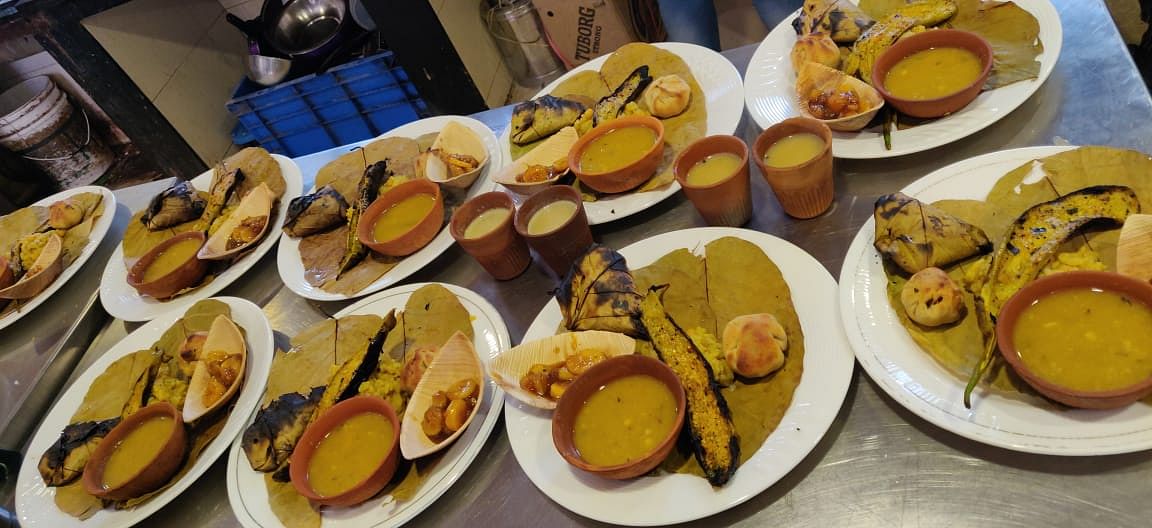
Without such exhaustive research, which was vetted by an expert, the National Museum would have never okayed the idea in the first place and they took a big risk by doing so, said Sudipto Sircar, a member of OSMS.
We know for sure that the people of the Indus Valley Civilisation were growing (in multi-crop patterns) and eating chickpeas, lentils, barley, brinjal, sesame, ginger, garlic, among other things. We also know they were eating fish, including Hilsa (at which point most of the Bengalis in my food walkthrough at the museum nodded in appreciation), fowl, and hunting for boars and deer. They were also keeping cattle and eating them — buffaloes, sheep, goat, and chickens.
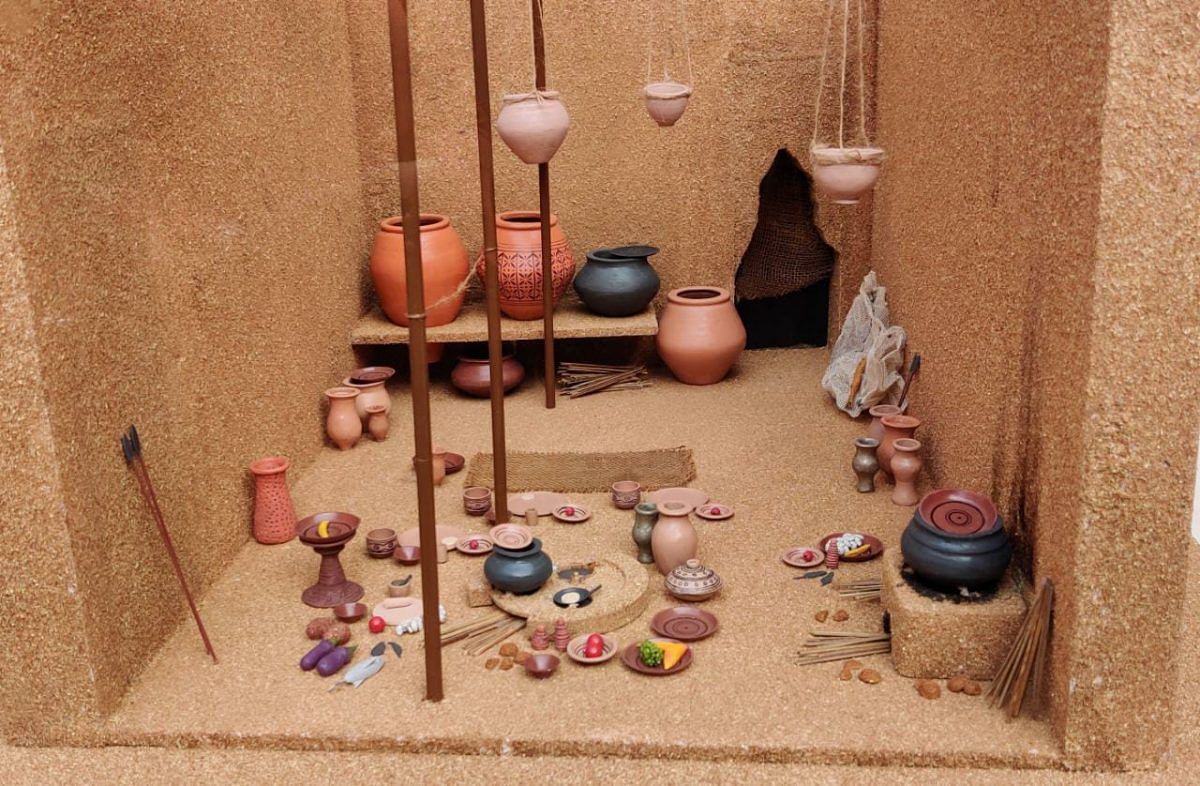
Their kitchen and hearth, probably community ones, are similar to those still found in rural India today. Wealthy dwellers had metal plates and pots (I think I even saw a frying pan). Storage pots and racks to dry fish were found in most houses. Some ruins even suggest they had the mud equivalent of dustbins.
It would be terribly inconsiderate to the Harappans, the ones who built roads at right angles and sewage systems that mock our current ones, to imagine that they only cooked and ate gruel or that their cooking techniques were rudimentary.
Also read: Kali Puja cuisine has veg mutton, chopsuey, biryani, guilt and Gelusil
What I ate
Two disclaimers before we move to the dining.
Don’t go to eat the food of the Indus Valley Civilisation if you expect and appreciate only flavours like those of Chhole Bhature and Laal Maas. Tomatoes, potatoes, and chillies are crops of the New World, and yes, there can be food without them. Also don’t go if you keep matching the taste of the food to a variant you eat now. Yes, food evolved but we are at dinner because we’ve never had what would have probably been eaten thousands of years ago.
We were first served split milk (chhena) and carrot on bread, and lamb liver mash on sunflower seed bread as appetisers. Both were delicious, but something has to be said about the liver mash tasting so good without the ‘masalas’. It went down fabulously with the sattu and whey water drink. Then came the quail wrapped in saal leaves (a bit dry).

Now let’s pause a moment for the meat fat and bone stock. It was everything I detested as a child drinking (because I was often ill, ‘tangri soup’ was a regular) but made so much sense in faraway Delhi. Cooked for over six hours in earthen pots, it was spoonfuls of nostalgia and my highlight of the meal. In an episode of Netflix’s Street Food shot in Taiwan, we see Mr Chou making ‘3 days 3 nights goat stew’ in earthen pots buried in the ground. He is one of the last people who make it because the fire is so hazardous. When you eat it finally, he says, you feel “your chi flow through the body”. This soup was no less. And if the average Harappan was actually six feet tall, they needed this.
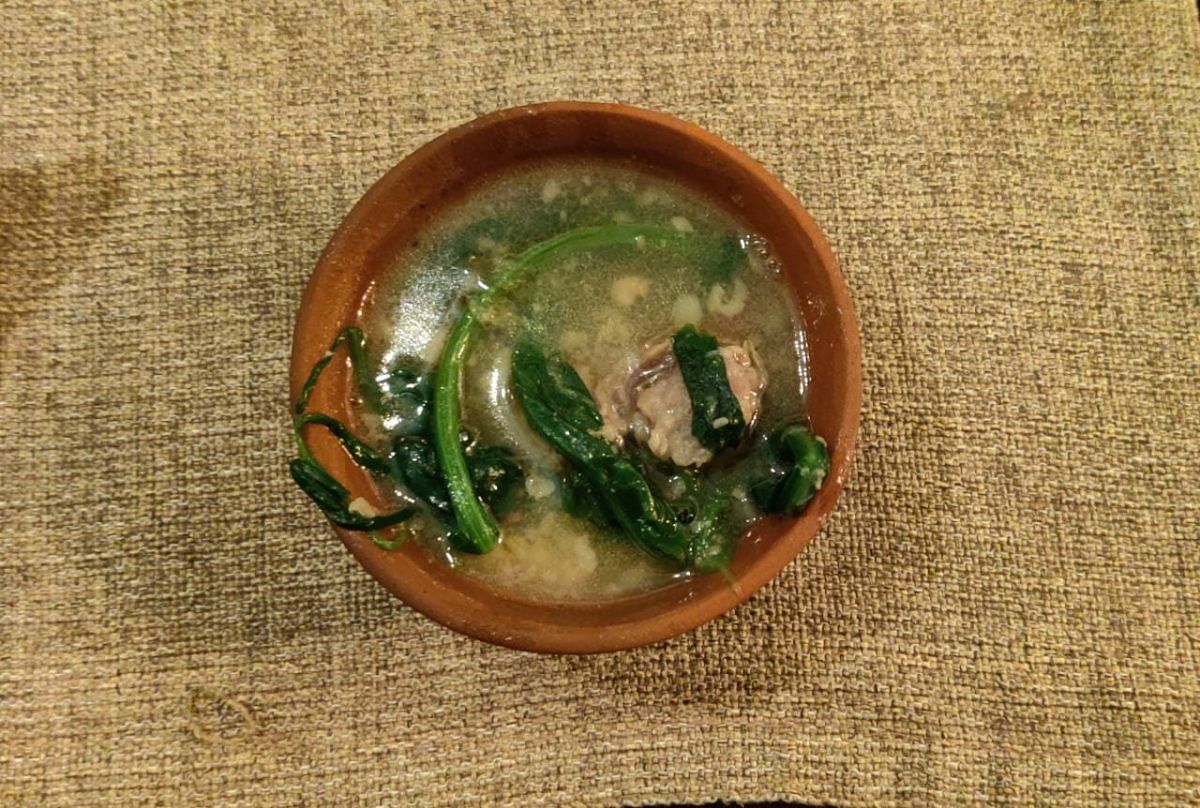
We were then served flame-grilled fish, soft and rubbed with turmeric, which melted in the mouth.
A platter came next. If you told me it was from a Bengali bhog, I would have believed you. Burnt crispy brinjal with mustard oil, millet and green moong khichdi, braised parwal (or potol, that undying vegetable), grilled yam and guava, and a date chutney that I wanted to buy a bottle of.
Soon came the dishes that made gods and their followers in the National Museum shudder — a deliciously buttery fowl curry (which my Sindhi friend on the table absolutely loved and said it reminded him of home), ancient style lamb offals (too strong and salty for my taste), and salt-cured baby lamb (guilt did not trip me that night and I devoured the soft meat chunks). Beef or buff was intentionally taken out of the menu even before the fiasco, to prevent just that.
And somehow, after all this Dionysian pleasure, we still had a spot for the dessert — oatmeal custard and ragi halwa (which looked like chocolate).
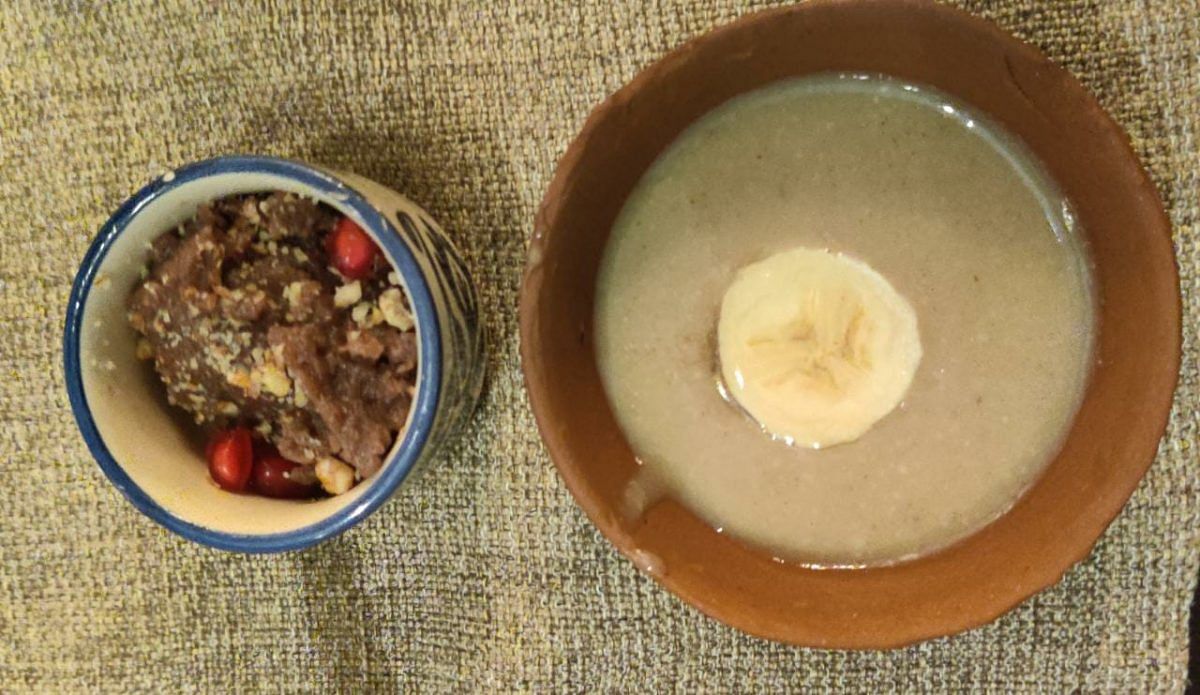
And through it all, I kept thinking: all of us found something similar to what we eat today, something very basic in our taste buds was making sense of this food that we had never eaten and yet we had. That thousands of years ago too, the taste of freshly made bread was as comforting to our ancestors. And that fire, salt, acid can never fail human beings.
Soumi Chatterjee told me that a group of people from Chhattisgarh’s Bastar had come to the National Museum to taste the Historical Gastronomica and said, “Food is in our DNA and our DNA is in this food.” Time for ‘pure veg’ India to think about that.


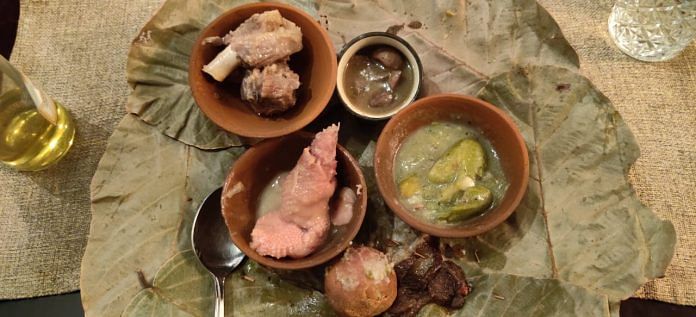

If you want to see your favourite animals , used as farm animals you must not fight against its meat as food. Farmers have no need it in agriculture as it is mechanised. They cannot sustain it as a home animal for milk only. Milk will be produced by dairies with genetically modified cows, pasturised and distributed without human effort. The horses are not to be seen in countru side. Beaf is recommended by Sushrutha, Charaka Vaghbhta as medicine and not prohibitted by vedas, Shruthis. Budhists do not kill but eat it as Delih Lama does it. Don’t put dirt in common man’s protein rich food. Those who are vegetarians don’t meddle with others food guaranteed by the Constitution.
This is an intellectual and scientific understanding of India’s past and food habits of our ancestors. They were meat lovers, ate beef regularly and there was perhaps no such thing as pure veg…, a later creation……
Is it required to simulate what happened thousands of years earlier? As somebody else pointed out there would have been cannibals. And there used to be slavery and fights between humans and carnivorous beasts. So this is clearly politics.
Then why is the author so intolerant of pure vegetarianism? Leave them alone to enjoy their food just like non vegetarians. It is only the author’s wild imagination that there is a notion of pure vegetarian India. India was always diverse and that includes non violent food habits too
And certainly any day eating without killing is more romantic than otherwise.
Then why can’t the beef eaters be left as u said to leave vegetarians… It is the bhadva jaati party entering into private privacy spaces like eating habits of people
We Indians always ate cow meet. Especially the bulls and cows that became too old for ploughing and diary needs. That’s a fact.
Clearly an attempt is being made to transform the eating habits of the vegetarian Indians. And how best to do it ? by slowly changing the perception of our history and culture. So you will see more reports and ” research articles ” stating that our ancestors were meant eaters. In the future this will be put on to the mainstream media and “normalised” for the vast majority of vegetarian Indians.
Clearly an attempt is being made to transform the eating habits of the vegetarian Indians. And how best to do it ? So there is a sustained attack against vegan culture in India by slowly changing the perception of our history and culture. So you will see more reports and ” research articles ” stating that our ancestors were meant eaters. In the future this will be put on to the mainstream media and “normalised” for the vast majority of vegetarian Indians.
Usually desert poeple eat food of animal origin most becoz noncivilisation. No irrigation they know. But harappans were good at irrigation. Was their culture taken over by desert poeple
This is the best write up on I ate the non vegetarian Harappan meal and had no beef with it. I really loved it and thank you very much for sharing this with us. You have a great visualization and you have really presented this content in a really good manner. They offer same information here Biltongplus.co.nz one must check them also.
What is the writer trying to accomplish by using words such as “delusion” and “pure veg”? The author is at best victim of the own stereotype she is trying to quash. Veg or Non veg – food is not delusional. It is based on the current climatic and topographical condition of a region.Trying to draw conclusions and raising that false flag of righteousness in food is a futile attempt at politicizing food .
I am not against history or facts. But is it necessary to reproduce something that was practised aeons ago.
I am sure cannibalism and human sacrifice was also practiced. I hope this author is not suggesting that we revive the practice in museums to give authenticity.
Funny logic people have.
Well said,sir. Let us assume that they found non vegetarian consumption proofs, if so what? How could they so sure that then also there are no vegetarianism practicing people? Suppose all are non vegetarians then, why can’t they turn to vegetarians mid way feeling hurt to kill animals for food and have vegetarian alternatives then? What is to be so joyful about it, if only to get vicarious satisfactions in ridiculing vegetarians which, ofcourse, care a hoot. It’s new ploy of beef eaters to divide vegetarian and non vegetarians by targeting vegetarians by which BJP, which they call vegetarian Hindu party opposed to non vegetarian Hindus of south as they call themselves and is propagated by DMK’s beef eating christians and is prevalent in Kerala and one Kanche Ilaah in AP propagates it ,Siddaramaiah in Karnataka and Osmania University campus students where beef festivals arranged to ridicule ABVP,BJP do it.
Well said,sir. Let us assume that they found non vegetarian consumption proofs, if so what? How could they so sure that then also there are no vegetarianism practicing people? Suppose all are non vegetarians then, why can’t they turn to vegetarians mid way feeling hurt to kill animals for food and have vegetarian alternatives then? What is to be so joyful about it, if only to get vicarious satisfactions in ridiculing vegetarians which, ofcourse, care a hoot. It’s new ploy of beef eaters to divide vegetarian and non vegetarians by targeting vegetarians by which BJP, which they call vegetarian Hindu party opposed to non vegetarian Hindus of south as they call themselves and is propagated by DMK’s beef eating christians and is prevalent in Kerala and one Kanche Ilaah in AP propagates it ,Siddaramaiah in Karnataka and Osmania University campus students where beef festivals arranged to ridicule ABVP,BJP do it.They shapelessly showed killing live cow. But left, liberal of at least dare not condemn them though we can’t expect from minorities who, rather, rejoice it.
Extremely beautifully written article. Now to taste some of that off-limit beef!